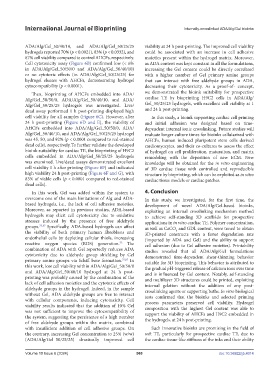Page 568 - IJB-10-6
P. 568
International Journal of Bioprinting Internally-crosslinked ADA/Alg/Gel bioinks
ADA/Alg/Gel_50/40/10, and ADA/Alg/Gel_50/25/25 viability at 24 h post-printing. The improved cell viability
hydrogels reported 70% (p < 0.0021), 83% (p < 0.0332), and could be associated with an increase in cell adhesive
87% cell viability compared to control AHCFs, respectively. moieties present within the hydrogel matrix. Moreover,
Cell cytotoxicity assay (Figure 6B) confirmed low (< 6% as ADA content was kept constant in all the formulations,
in ADA/Alg/Gel_50/50/0 and ADA/Alg/Gel_50/40/10) increasing the Gel content could be directly correlated
or no cytotoxic effects (in ADA/Alg/Gel_50/25/25) for with a higher number of Gel primary amine groups
hydrogel eluates with AHCFs, demonstrating hydrogel that can interact with free aldehyde groups in ADA,
cytocompatibility (p < 0.0001). decreasing their cytotoxicity. As a proof-of- concept,
Then, bioprinting of AHCFs embedded into ADA/ we demonstrated the bioink suitability for prospective
Alg/Gel_50/50/0, ADA/Alg/Gel_50/40/10, and ADA/ cardiac TE by bioprinting H9C2 cells in ADA/Alg/
Alg/Gel_50/25/25 hydrogels was investigated. Live/ Gel_50/25/25 hydrogels, with excellent cell viability at 1
dead assay performed 1 h post-printing displayed high and 24 h post-printing.
cell viability for all samples (Figure 6C). However, after In this study, a bioink supporting cardiac cell printing
24 h post-printing (Figure 6D and E), the viability of and initial adhesion was designed based on time-
AHCFs embedded into ADA/Alg/Gel_50/50/0, ADA/ dependent internal ionic crosslinking. Future studies will
Alg/Gel_50/40/10, and ADA/Alg/Gel_50/25/25 hydrogel evaluate longer culture times for bioinks cellularized with
was 45, 50, and 92% (p < 0.0001 compared to red-stained AHCFs, human induced pluripotent stem cells derived
dead cells), respectively.To further validate the developed cardiomyocytes. and their co-cultures to assess the effect
bioink suitability for cardiac TE, the bioprinting of H9C2 of hydrogel on cell proliferation, maturation, and matrix
cells embedded in ADA/Alg/Gel_50/25/25 hydrogels remodeling with the deposition of new ECM. New
was examined. Live/dead assays demonstrated excellent knowledge will be obtained for the in vitro engineering
cell viability 1 h after printing (Figure 6F) and indicated of 3D cardiac tissue with controlled and reproducible
high viability 24 h post-printing (Figure 6F and G), with structure by bioprinting, which can be exploited as in vitro
83% of viable cells (p < 0.0001 compared to red-stained cardiac tissue models or cardiac patches.
dead cells).
In this work, Gel was added within the system to 4. Conclusion
overcome one of the main limitations of Alg and ADA- In this study, we investigated, for the first time, the
based hydrogels, i.e., the lack of cell adhesive moieties. development of novel ADA/Alg/Gel-based bioinks,
Moreover, as reported in previous studies, ADA-based exploiting an internal crosslinking mechanism method
hydrogels may elicit cell cytotoxicity due to oxidative to achieve self-standing 3D scaffolds for prospective
stresses induced by the presence of free aldehyde applications in in vitro cardiac TE. Polymer concentration,
groups. 75,87 Specifically, ADA-based hydrogels can affect as well as CaCO and GDL content, were tuned to obtain
3
the viability of both primary human fibroblasts and 3D-printed constructs with a faster degradation rate
endothelial cells by depleting cellular thiols, increasing (imparted by ADA and Gel) and the ability to support
reactive oxygen species (ROS) generation. The cell adhesion (due to Gel adhesive moieties). Printability
75
combination of ADA with Gel reportedly reduces ADA studies revealed that all ADA/Alg/Gel formulations
cytotoxicity due to aldehyde group shielding by Gel demonstrated time-dependent shear-thinning behavior
primary amine groups via Schiff base formation. 75,87 In suitable for 3D bioprinting. This behavior is attributed to
this work, low cell viability within ADA/Alg/Gel_50/50/0 the gradual pH-triggered release of calcium ions over time
and ADA/Alg/Gel_50/40/10 hydrogel at 24 h post- and is influenced by Gel content. Notably, self-standing
printing was probably caused by the combination of the and multilayer 3D structures could be printed, exploiting
lack of cell adhesion moieties and the cytotoxic effects of internal gelation without the addition of any post-
aldehyde groups in the hydrogel. Indeed, in the sample crosslinking agents or supporting baths. In vitro biological
without Gel, ADA aldehyde groups are free to interact tests confirmed that the bioinks and selected printing
with cellular components, inducing cytotoxicity. Cell process parameters preserved cell viability. Hydrogel
viability results indicated that the addition of 10% Gel composition with the highest Gel content was able to
was not sufficient to improve the cytocompatibility of support the viability of AHCFs and H9C2 embedded in
the system, suggesting the persistence of a high number the hydrogels, at 24 h post-printing.
of free aldehyde groups within the matrix, combined
with insufficient addition of cell adhesive groups. On Such innovative bioinks are promising in the field of
the contrary, increasing Gel concentration to 25% (w/w) soft TE, particularly for prospective cardiac TE, due to
(ADA/Alg/Gel_50/25/25) drastically improved cell the cardiac tissue-like stiffness of the inks and their ability
Volume 10 Issue 6 (2024) 560 doi: 10.36922/ijb.4014

